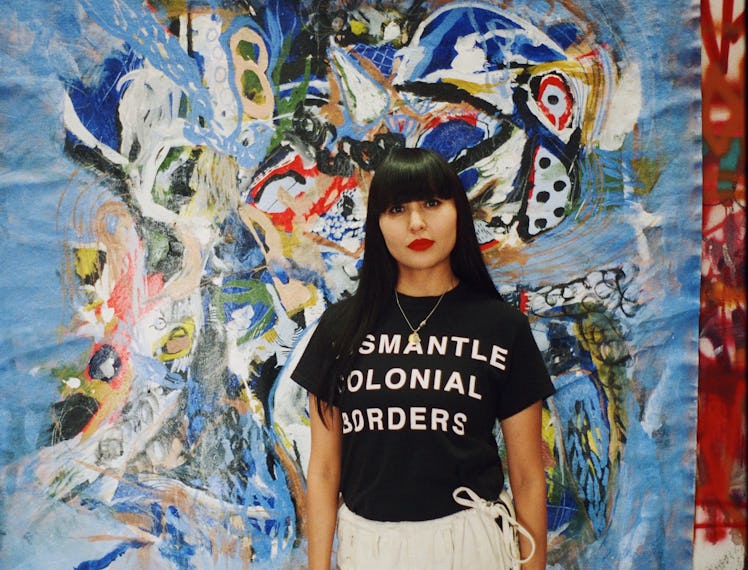Nizhonniya Austin is a hardcore daydreamer. As much of a poet as she is a painter, the Diné and Tlingit artist convenes with the unseen—her ancestors, her own spirit—to produce artworks bursting with pride, vulnerability, and possibility. For The Year of the Vampire, Austin’s debut solo exhibition at Tara Downs gallery in New York, the artist offers a dazzling collection of large-scale acrylic, oil, and wax pencil works, which reflect intimate vignettes of her life.
“I have a very personal and spiritual relationship with my paintings,” Austin, an Albuquerque native who studied painting at Santa Fe’s Institute of American Indian Arts, tells W. “Often, when I’m painting, I’m moving around and around in circles. It’s become this meditative dance, this ritual. They’re conversations with my ancestors.”
The fact that Austin—who is both a painter and an actor, having starred in Showtime’s 2023 series The Curse alongside Emma Stone—makes artworks from movement is strikingly evident, even after only a few moments of engagement with her sprawling compositions. “I think of my paintings as prayers,” Austin adds. “Most of the time, it feels like I’m being spoken to. The way that my whole body moves, it’s like it has become a tool, or a vessel. Sometimes my body does really weird movements when I’m doing the paintings and I don’t even know why I moved in that way.”
Nizhonniya Austin, There’s Always Some God To Battle… Some Mountain To Climb… Some Song To Dance To, 2024.
Through this dialogue, the L.A.-based artist furthers her exploration of the body’s role in translating movement to a visual form. Sharp intuition and a willingness to be guided by something beyond herself manifests in reverberant paintings composed of circumlinear forms, as well as traces of anthropomorphic figures. Austin’s canvases also nod to a tradition of Abstract Expressionist artists who maintain that a “good” painting is as much about its iterations and process as it is about the work in a completed form.
Nizhonniya Austin, The Problem Wasn’t Us It Was the World, 2024.
As Austin becomes the conduit through which time, space, and memory are transcribed, intricate networks of gestures leap from her canvases. Her artwork titles also tend to possess a narrative quality, a quiet poeticism stemming from the stories she’s “always fantasizing about” in her head. In There’s Always Some God To Battle... Some Mountain To Climb... Some Song To Dance To, the artist presents a cacophonous environment that embodies the motion from which it materialized. Even without the presence of the artwork title, the painting calls to mind a web of small, yet explosive movements, eventually coming together in a rupture so grand, it can only be characterized as cosmic. And an energizing range of green and purple hues coalesce in The Problem Wasn’t Us It Was the World. Within this fantastical landscape, the artist suggests a tone of vitality and strength.
While Austin’s Native heritage plays an integral part in understanding of her work, it is just one element of a complex network of references and experiences that make up her artistic practice. She is committed to resisting the pressures inflicted by the art world to perform her identity in a palatable or oversimplified manner. “I really support fluidity and being in the in-between,” she adds. “I shouldn’t have to define my existence. As a Native person, you’re already walking in both worlds.”
The Year of the Vampire is on view at Tara Downs gallery through February 22.
